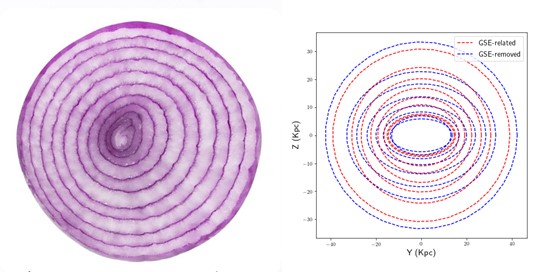You are here
LAMOST reveals the influence of the GSE on the stellar halo
When you look at beautiful stars in the sky, do you want to know where they are from? Are they formed as an original part of the Milky Way or from another galaxy disappeared several billion years ago?
A recent study lead by Prof. Gang Zhao, Prof Xiang-Xiang Xue, and Dr. Wenbo Wu from National Astronomical Observatories of Chinese Academy of Sciences (NAOC) reveals the influence of a past major merger event on the density profile of the Galactic stellar halo, using about ten thousand K giants from the LAMOST survey.
This study was published in the Astronomical Journal.
“Our Milky Way is a disc like galaxy, and it is wrapped in an ellipsoid structure,” said Dr. Wenbo Wu, who is the first author of this research paper. “We define the stellar component of this ellipsoid structure as the stellar halo.”
The global structure of the stellar halo is similar to an onion. It is oblate in the inner part, while spherical in the outer part.
Around 10 billion years ago, a very large dwarf galaxy named as the Gaia-Sausage-Enceladus (GSE) fallen down into the Milky Way. This galaxy was torn into pieces by the strong gravitational force.
Just like a mix of two different colors can produce a new color. The current stellar halo is a mix of the in-situ halo stars and GSE stars.
“We select stars related to the Gaia-Sausage-Enceladus and define them as the GSE-related stellar halo,” said Dr. Wenbo Wu. “The other halo stars are defined as the GSE-removed stellar halo.”
The researchers find that both stellar halos have onion-like shape. However, the GSE-related stellar halo is less flattened than the GSE-removed stellar halo. In short words, the GSE-related stellar halo is a more spherical “onion”.
It means that the stellar halo could evolve into a more spherical shape due to this merger event. Besides the observational evidence, the researchers also explored two Milky Way analogous in the TNG50 cosmological simulation and a similar trend was found.
“In the past, we have to rely on a very small sample of halo stars to study the structure of the stellar halo. Nowadays, the development of large spectroscopic surveys like the LAMOST, APOGEE, and Gaia allow us to draw a more precise paint of the Milky Way,” said Prof. Gang Zhao, the co-corresponding author of this study.
The referee thinks highly of this paper: “The study is timely and the results represent a valuable contribution to our understanding of the formation of the Milky-Way's stellar halo.”

Figure: The left panel shows the cross section of an onion. The right panel shows the contour of density profiles of the two stellar halos. We can see that both the two stellar halos have an onion like shape, while the GSE-related stellar halo (red dashed lines) is a more spherical onion. (Credit: Wenbo Wu)
The paper can be accessed at: https://iopscience.iop.org/article/10.3847/1538-3881/ac746e
